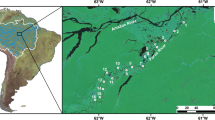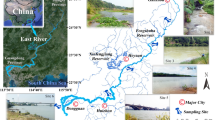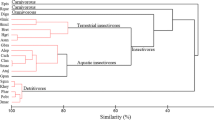Synopsis
The fish fauna of the Mulgrave and South Johnstone rivers is diverse relative to other Australian rivers and this study examines the diets of many of the resident fish species. Most species were small (< 200 g), and although considerable overlap in the size of the mouth was observed, closely related species tended to have non-overlapping ranges in mouth size. Five trophic guilds were recognised and substantial discrimination between guilds on the basis of body size was noted. Small fishes (< 5 gm body weight) consumed a variety of insect larvae and small terrestrial insects. The diet of large fish was characterised by the presence of large aquatic invertebrates and fish. A third group of intermediate sized fishes (10–20 gm), which included the 0+ age class of three species of large fish, also consumed aquatic invertebrates but only a small proportion of terrestrial invertebrates. Vegetable material was present in the diet of all three guilds but the source of that material varied. In groups 1 to 3 above, the source of that material was desmids and diatoms, aquatic macrophytes or filamentous alga respectively. A fourth guild fed predominately on detritus and some bivalve molluscs, and a fifth group, containing only two species, fed feavily on gastropod molluscs. The extent of dietary overlap varied both within- and between-rivers. In habitats dominated by low water velocities and sandy substrates, resource partitioning was pronounced and the number of fishes with empty or near empty guts was high, suggesting that food was more limited in this type of habitats. Little resource partitioning was observed in habitats characterised by a coarse substrate, high water velocity and dense riparian canopy.
Similar content being viewed by others
References cited
Angermeier, P.L. & J.R. Karr. 1983. Fish communities along environmental gradients in a system of tropical streams. Env. Biol. Fish. 9: 117–135.
Arthington, A.H. 1992. Diets and trophic guild structure of freshwater fishes in Brisbane streams. Proc. Roy. Soc. Qld. 102: 31–47.
Barlow, G.W. & J.W. Munsey. 1976. The red devil-midas-arrow cichlid species complex in Nicaragua. pp. 359–369 In: T.B. Thorson (ed.) Investigations of the Ichthyofauna of Nicaraguan Lakes, University of Nebraska, Lincoln.
Fryer, G. & T.D. Iles. 1972. The cichlid fishes of the Great Lakes of Africa. Oliver and Boyd, Edinburgh. 641 pp.
Greenwood, P.H. 1973. Morphology, endemism and speciation in African cichlid fishes. Verhandl. Deutsch. Zool. Gesellsch. 66: 115–124.
Grossman, G.D., P.B. Moyle & J.O. Whittaker, Jr. 1982. Stochasticity in structural and functional characteristics of an Indiana stream fish assemblage: a test of community theory. Amer. Nat. 120: 423–454.
Hespenheide, H.A. 1975. Prey characteristics and predator niche width. pp. 158–180. In: M.L. Cody & J.M. Diamond (ed.) Ecology and Evolution of Communities, Belknap Press, Cambridge.
Hill, M.O. 1979. TWINSPAN — A Fortran program for arranging multivariate data in an ordered two-way table by classification of the individuals and attributes. Ecology and Systematics Section, Cornell University, Ithaca. 90 pp.
Holbrook, S.J. & R.J. Schmidt. 1989. Resource overlap, prey dynamics, and the strength of competition. Ecology 70: 1943–1953.
Hortle, K.G. & R.G. Pearson. 1990. Fauna of the Annan River system, far north Queensland, with reference to the impact of tin mining. I. Fishes. Aust. J. Mar. Freshw. Res. 41: 677–694.
Horwitz, R.J. 1978. Temporal variability patterns and the distributional patterns of stream fishes. Ecol. Monog. 48: 307–321.
Hyslop, E.J. 1980. Stomach contents analysis — a review of methods and their application. J. Fish Biol. 17: 411–429.
Levins, R. 1968. Evolution in changing environments. Princeton University Press, Princeton. 120 pp.
Linton, L.R., R.W. Davies & F.J. Wrona. 1981. Resource utilization indices: an assessment. J. Anim. Ecol. 50: 283–292.
Mathur, D. 1977. Food habits and competitive relationships of the bandfin shiner in Halawakee Creek, Alabama. Amer. Midi. Nat. 97: 89–100.
McDonald, N.S. & J. McAlpine. 1991. Floods and droughts: the northern climate. pp. 19–29. In: C.D. Haynes, M.G. Ridpath & M.A. Williams (ed.) Monsoonal Australia: Landscape, Ecology and Man in the Northern Lowlands, A.A. Balkema, Rotterdam.
McMahon, T.A. 1986. Hydrology and management of Australian streams. pp. 23–44. In: I.C. Campbell (ed.) Stream Protection: the Management of Streams for Instream Uses, Water Studies Centre, Chisholm Institute of Technology, Melbourne.
McMahon, T.A. 1989. Understanding Australian streamflow — implications for Instream ecology. pp. 1–11. In: C. Teoh (ed.) Proceedings of the Specialist Workshop on Instream Needs and Water Uses, Australian Water Resources Council, Canberra.
Meffe, G.K. & A.L. Sheldon. 1988. The influence of habitat structure on fish assemblage composition in south-eastern blackwater streams. Amer. Midl. Nat. 120: 225–240.
Meffe, G.K. & A.L. Sheldon. 1990. Post-defaunation recovery of fish assemblages in southeastern blackwater streams. Ecology 71: 657–667.
Meffe, G.K. & W.L. Minkley. 1987. Persistence and stability of fish and invertebrate assemblages in a repeatably disturbed Sonoran Desert stream. Amer. Midl. Nat. 117: 177–191.
Mendelson, J. 1975. Feeding relationships among species ofNotropis (Pisces: Cyprinidae) in a Wisconsin stream. Ecol. Monogr. 45: 199–230.
Merrick, J.R. & G.E. Schmida. 1984. Australian freshwater fishes: biology and management. Griffin Press, Netley. 409 pp.
Mittelbach, G. 1986. Predator-mediated habitat use: some consequences for species interactions. Env. Biol. Fish. 16: 159–169.
Morisita, M. 1959. Measuring of interspecific association and similarity between communities. Mem. Fac. Sci. Kyushu University Series E3: 64–80.
Moyle, P.B. & F.R. Senanyake. 1984. Resource partitioning among the fishes of rainforest streams in Sri Lanka. J. Zool. Lond. 202: 195–223.
Pianka, E.R. 1969. Habitat specificity, speciation and species density in Australian desert lizards. Ecology 50: 498–502.
Prejs, A. 1987. Risk of predation and feeding rate in tropical freshwater fishes: field evidence. Oecologia 72: 259–262.
Pusey, B.J., A.H. Arthington & M.G. Read. 1993. Spatial and temporal variation in fish assemblage structure in the Mary River, south-eastern Queensland: the influence of habitat structure. Env. Biol. Fish. 37: 355–380.
Pusey, B.J., A.H. Arthington & M.G. Read. 1994. Species richness and spatial variation in fish assemblage structure in two rivers of the wet-tropics of northern Queensland. Env. Biol. Fish. (in press).
Ricklefs, R.E. & M. Lau. 1980. Bias and dispersion of overlap indices: results of some Monte Carlo simulations. Ecology 61: 1019–1024.
Richardson, B.A. 1986. Evaluation of in-stream flow methodologies for freshwater fish in New South Wales. pp. 23–44. In: I.C. Campbell (ed.) Stream Protection: the Management of Stream for In-Stream Uses, Water Studies Centre, Chisholm Institute of Technology, East Caulfield.
Root, R.B. 1967. The niche exploitation pattern of the blue-grey gnat-catcher. Ecol. Monog. 37: 317–350.
Ross, S.T, W.J. Matthews & A.A. Eschelle. 1985. Persistence of stream fish assemblages: effects of environmental change. Amer. Nat. 126: 24–40.
Schlosser, I.J. 1982. Fish community structure and function along two habitat gradients in a headwater stream. Ecol. Monogr. 52: 395–414.
Schlosser, I.J. 1985. Flow regime, juvenile abundance and the assemblage structure of stream fishes. Ecology 66: 1484–1490.
Schlosser, I.J. 1987. A conceptual framework for fish communities in small warmwater streams. pp. 17–24. In: W.J. Matthews & D.C. Heins (ed.) Community and Evolutionary Ecology of North American Stream Fishes, University of Oklahoma Press, Norman.
Schlosser, I.J. & L.A. Toth. 1984. Niche relationships and population ecology of rainbow (Etheostoma caeruleum) and fantail (E. flabellare) darters in a temporally variable environment. Oikos 42: 229–238.
Schoener, T.W. 1974. Resource partitioning in ecological communities. Science 185: 27–39.
Smith, E.P. 1985. Estimating the reliability of diet overlap measures. Env. Biol. Fish. 13: 125–138.
Smith, E.P. & T.M. Zaret. 1982. Bias in estimating niche overlap. Ecology 63: 1248–1253.
Werner, E.E., J.F. Gilliam, D.J. Hall & G.G. Mittlebach. 1983. An experimental test of the effects of predation risk on habitat use in fish. Ecology 64: 1540–1548.
Whitman, R.L. & W.J. Clark. 1984. Ecological studies of the sand-dwelling community of an East Texas stream. Freshw. Invertebr. Biol. 3: 59–80.
Winemiller, K.O. 1989. Ontogenetic diet shifts and resource partitioning among piscivorous fish in the Venezuelan Ilanos. Env. Biol. Fish. 26: 177–199.
Zaret, T.M. & E.P. Smith. 1984. On measuring niches and not measuring niches. pp. 127–437. In: T.M. Zaret (ed.) Evolutionary Ecology of Neotropical Freshwater Fishes, Developments in EBF 3, Dr W. Junk Publisher, The Hague.
Author information
Authors and Affiliations
Rights and permissions
About this article
Cite this article
Pusey, B.J., Read, M.G. & Arthington, A.H. The feeding ecology of freshwater fishes in two rivers of the Australian wet tropics. Environ Biol Fish 43, 85–103 (1995). https://doi.org/10.1007/BF00001820
Received:
Accepted:
Issue Date:
DOI: https://doi.org/10.1007/BF00001820




